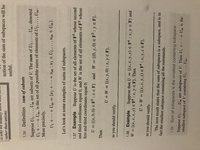babadany2999
New member
- Joined
- Jun 9, 2020
- Messages
- 6
I'm having trouble understanding the exercise done in the book.Suppose U={(x,x,y,y) belonging to F4 : x,y belong to F} 6 ^ W = {(x,x,x,y) belonging to F4 : x,y belong to F}
In the book it says U+V = {(x,x,y,z) belonging to F4 : x,y,z belong to F} .I'm having trouble understanding this,where did the z come from,shouldn't we have on the 4th position y? And in the third why is x+y=y?Thanks for the help!
In the book it says U+V = {(x,x,y,z) belonging to F4 : x,y,z belong to F} .I'm having trouble understanding this,where did the z come from,shouldn't we have on the 4th position y? And in the third why is x+y=y?Thanks for the help!

